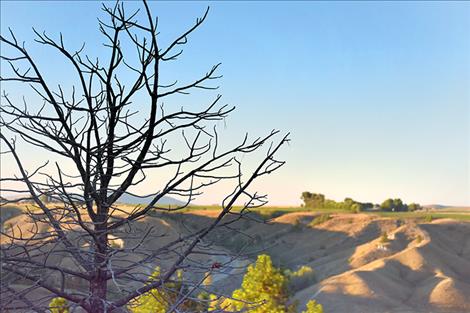Fires cause permanent damage as weather warms
Hey savvy news reader! Thanks for choosing local.
You are now reading
1 of 3 free articles.
Grass could soon replace the evergreens that blanket the base of the Mission Mountains, according to a new study.
As summer weather gets hotter and dryer, ponderosa pines and Douglas fir seedlings in the northwest United States are less likely to survive to maturity, a study from the University of Montana shows. Those same weather conditions make wildfires more likely to decimate evergreen forests. As a result, forests that burn today may never grow back.
“The trees are becoming vulnerable to catastrophic losses due to fire,” said Solomon Dobrowski, an author of the study.
For example, a swath of forest southwest of Ronan is full of charred trees that may never be replaced after burning in July’s Moss Ranch Fire.
The potential for bald hills isn’t just a result of warm, dry, average temperatures, though the last five years in northwestern states have been the hottest on record. Researchers also observe fewer abnormally cool, wet periods. Before the 1990s, the region saw this type of weather every few years, the study states. The study attributes the shifts in weather to human-caused climate change.
Increased drought and temperature means wildfires blaze much hotter and larger than they did in the past. These fires destroy seeds that under previous weather conditions could have grown into trees.
The seeds that do survive wildfires struggle to grow into full-sized trees today. Chances that a ponderosa pine will grow to maturity are low, even in the most nurturing conditions, according to the study. Weak seedlings need moisture and low temperatures to grow into mature trees. Those conditions are rare in recent years, so trees are unable to survive past their first year.
The study was conducted at 90 wildfire sites in the northwest United States. It shows that between 1990 and 2015 many previously forested sites became unable to regenerate trees due to weather.
The cycle of burning and regeneration is a hallmark of forests in the northwest. Weather changes will stop that cycle, transforming areas covered by evergreen forest into other types of ecosystems. They will likely be replaced by grassland, Dobrowski said.
Fewer trees reduce opportunities for skiing and mountain biking in forested terrain. Loggers will see their harvests shrink. Clean water may become scarce, as trees also filter impurities from groundwater, according to the study. Without forests the region will become even hotter, as trees absorb energy and keep their surrounding areas cool, Dobrowski said.
Though the change seems alarming, shifting plant distribution is a normal part of earth’s existence, said Dobrowski. Some evergreen forests seen as integral to the Mission Valley ecosystem have only existed for a few thousand years. Weather changes kill some trees and allow others to survive; however, the last 20 years have seen weather change occurring faster than scientists have ever recorded in the past. “What we don’t know is whether the plants can keep up,” Dobrowski said.
















